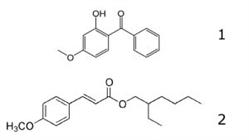Oxybenzone and Octinoxate Analyzed by HPLC - AppNote
November 8, 2012
/
/
/
/
/
Separation of Two APIs in Chap Stick® Extract
This Method shows how two common ingredients found in sunscreens and lip balms can be separated. The two compounds are very hydrophobic, so a Mobile Phase Gradient with significant organic content was used in order to avoid excessive retention.
Likewise, a highly organic diluent should be used to adequately extract the compounds from the lip balm material. The figure below shows an overlay of two runs from different Column lots, demonstrating the robustness and precision of the Method.


Temperature: 40˚C
Post Time: 3 minutes
Injection vol.: 2μL
Flow rate: 1.0mL / minute
Detection: UV @ 288nm
Sample Preparation: 250mg of ChapStick containing 7.5% Octinoxate and 3.5% Oxybenzone was weighed in a 25mL volumetric flask and a portion of 90:10 Acetonitrile / DI Water was added. It was sonicated for 30 minutes and diluted to mark. Then a portion was filtered with a 0.45µm Nylon Syringe Filter (MicroSolv Tech Corp.). The filtrate was diluted 1:10 for injections.
t0: 0.9 minutes
Note: These two compounds exhibit strong absorbance in the UV range, hence the wavelength of 288nm that was chosen. This behavior accounts for their use as sunscreen agents; UV radiation that is absorbed by the compounds is then prevented from reaching the skin and causing damage.

Attachment
No 216 Oxybenzone and Octinoxate Analyzed by HPLC pdf 0.3 Mb Download File
This Method shows how two common ingredients found in sunscreens and lip balms can be separated. The two compounds are very hydrophobic, so a Mobile Phase Gradient with significant organic content was used in order to avoid excessive retention.
Likewise, a highly organic diluent should be used to adequately extract the compounds from the lip balm material. The figure below shows an overlay of two runs from different Column lots, demonstrating the robustness and precision of the Method.


Peaks:
1. Oxybenzone
2. Octinoxate
Method Conditions
Column: Cogent Bidentate C18™, 4μm, 100Å
Catalog No.: 40018-75P
Dimensions: 4.6 x 75mm
Mobile Phase:
—A: DI Water / 0.1% Formic Acid (v/v)
—B: Acetonitrile / 0.1% Formic Acid (v/v)
Gradient:
| Time (minutes) | %B |
| 0 | 60 |
| 1 | 60 |
| 4 | 100 |
| 6 | 100 |
| 7 | 60 |
Post Time: 3 minutes
Injection vol.: 2μL
Flow rate: 1.0mL / minute
Detection: UV @ 288nm
Sample Preparation: 250mg of ChapStick containing 7.5% Octinoxate and 3.5% Oxybenzone was weighed in a 25mL volumetric flask and a portion of 90:10 Acetonitrile / DI Water was added. It was sonicated for 30 minutes and diluted to mark. Then a portion was filtered with a 0.45µm Nylon Syringe Filter (MicroSolv Tech Corp.). The filtrate was diluted 1:10 for injections.
t0: 0.9 minutes
Note: These two compounds exhibit strong absorbance in the UV range, hence the wavelength of 288nm that was chosen. This behavior accounts for their use as sunscreen agents; UV radiation that is absorbed by the compounds is then prevented from reaching the skin and causing damage.

Attachment
No 216 Oxybenzone and Octinoxate Analyzed by HPLC pdf 0.3 Mb Download File
